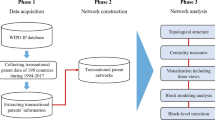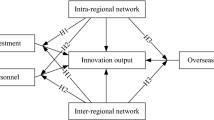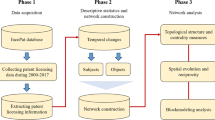Abstract
Over the past two decades, the number of international cooperative patents has grown significantly with the development of globalization. Although previous studies have almost exclusively used econometric methods, we argue that international cooperative patents change over time and that the relevant actors are dynamic, connected, and coexist to determine a country’s position in the international network of such patents. This study verified that different dimensions in the growth trajectory of the central patent international cooperative network curve form covariance structure perspectives using a latent growth curve model. Additionally, past studies have rarely examined whether technological concentration affects national technology innovation capacities; here, we integrated technological concentration with the estimation model. The results indicated that knowledge stock has a positive effect on the evolutionary growth rate of international cooperative patent network centrality. Moreover, technological concentration was found to strengthen the effect of knowledge stock on network centrality. An experimental map was produced to illustrate the interrelationships of the dimensions, which may be used as a reference by the government.


Similar content being viewed by others
Notes
These countries comprise: Austria, Australia, Belgium, Brazil, Canada, Switzerland, China Mainland, Czech Republic, Germany, Denmark, Spain, Finland, France, the United Kingdom, Greece, Hong Kong, Hungary, Ireland, Israel, India, Italy, Japan, Korea, Luxembourg, Malaysia, Netherlands, Norway, New Zealand, Poland, Russia, United Arab Emirates, Sweden, Singapore, Taiwan, the United States, and South Africa.
References
Abuhamad, A., & Shaltoni, A. M. (2013). Open innovations and international collaboration in the context of emerging economies. International Journal of Business and Management, 8(8), 12–21.
Al-Laham, A., Tzabbar, D., & Amburgey, T. L. (2011). The dynamics of knowledge stocks and knowledge flows: Innovation consequences of recruitment and collaboration in biotech. Industrial and Corporate Change, 20(2), 555–583.
Archibugi, D., & Coco, A. (2005). Measuring technological capabilities at the country level: A survey and a menu for choice. Research Policy, 34(2), 175–194.
Archibugi, D., & Michie, J. (1995). The globalization of technology: A new taxonomy. Cambridge Journal of Economics, 19(1), 121–140.
Archibugi, D., & Pianta, M. (1992). Specialization and size of technological activities in industrial countries: The analysis of patent data. Research Policy, 21(1), 79–93.
Archibugi, D., & Pianta, M. (1996). Measuring technological change through patents and innovation surveys. Technovation, 16(9), 451–468.
Balconi, M., & Laboranti, A. (2006). University-industry interactions in applied research: The case of microelectronics. Research Policy, 35(10), 1616–1630.
Basilevsky, A. (1994). Statistical factor analysis and related methods: Theory and applications. London: Wiley.
Bass, S. D., & Kurgan, L. A. (2010). Discovery of factors influencing patent value based on machine learning in patents in the field of nanotechnology. Scientometrics, 82(2), 217–241.
Bergek, A., & Bruzelius, M. (2010). Are patent with multiple inventors from different countries a good indicator of international R&D collaboration? The case of ABB. Research Policy, 39(10), 1321–1334.
Boldi, P., & Vigna, S. (2014). Axioms for centrality. Internet Mathematics, 10(3–4), 222–262.
Bollen, K. A., & Curran, P. J. (2006). Latent curve models: A structural equation perspective. Hoboken, NJ: Wiley.
Borgatti, S. P. (2006). Identifying sets of key players in a social network. Computational and Mathematical Organization Theory, 12(1), 21–34.
Boschma, R., & Frenken, K. (2010). The spatial evolution of innovation networks: A proximity perspective. In R. Boschma & R. Martin (Eds.), The handbook of evolutionary economic geography (pp. 120–135). Cheltenham: Edward Elgar.
Bosworth, D. L. (1984). Foreign patent flows to and from the United Kingdom. Research Policy, 13(2), 115–124.
Branstetter, L. G., Fisman, R., & Foley, C. F. (2006). Do stronger intellectual property rights increase international technology transfer? Empirical evidence from US firm level panel data. Quarterly Journal of Economics, 121(1), 321–349.
Breschi, S., & Lissoni, F. (2009). Mobility of skilled workers and co-invention networks: an anatomy of localized knowledge flows. Journal of Economic Geography, 9(4), 439–468.
Breschi, S., Malerba, F., & Orsenigo, L. (2000). Technological regimes and Schumpeterian patterns of innovation. Economic Journal, 110(463), 388–410.
Brockhoff, K. (1992). R&D cooperation between firms: A perceived transaction cost perspective. Management Science, 38(4), 514–524.
Byrne, B. M., & Crombie, G. (2003). Modeling and testing change: An introduction to the latent growth curve model. Understanding Statistics, 2(3), 177–203.
Cantner, U., & Graf, H. (2004). Cooperation and specialization in German technology regions. Journal of Evolutionary Economics, 14(5), 543–562.
Cantwell, J., & Vertova, G. (2004). Historical evolution of technological diversification. Research Policy, 33(3), 511–529.
Chang, S. H., & Chang, H. Y. (2013). Study on national innovation capacity and international connection. Innovation: Management, Policy and Practice, 15(4), 452–462.
Chang, P. L., & Shih, H. Y. (2005). Comparing patterns of intersectoral innovation diffusion in Taiwan and China: A network analysis. Technovation, 25(2), 155–169.
Chang, S. H., Wang, K. Y., Chih, W. H., & Tsai, W. H. (2012). Building customer commitment in business-to-business markets. Industrial Marketing Management, 41(6), 940–950.
Chen, Y. S., & Chang, K. C. (2010). The nonlinear nature of the relationships between the patent traits and corporate performance. Scientometrics, 82(1), 201–210.
Chen, J. H., Jang, S. L., & Chang, C. H. (2013). The patterns and propensity for international co-invention: The case of China. Scientometrics, 94(2), 481–495.
Cohen, W. M., & Levinthal, D. A. (1990). Absorptive capacity: A new perspective on learning and innovation. Administrative Science Quarterly, 35(1), 128–152.
Cummings, J. N., & Kiesler, S. (2007). Coordination costs and project outcomes in multi-university collaborations. Research Policy, 36(10), 1620–1634.
Davies, R. M. (1996). Industry-university collaborations: A necessity for the future. Journal of Dentistry, 4(1–2), 3–5.
Denisia, V. (2010). Foreign direct investment theories: An overview of the main FDI theories. European Journal of Interdisciplinary Studies, 3(10), 53–59.
Duso, T., Pennings, E., & Seldeslachts, J. (2009). Learning dynamics in research alliances: A panel data analysis. Research Policy, 39(6), 776–789.
Eaton, J., & Kortum, S. (1996). Trade in ideas-patenting and productivity in the OECD. Journal of International Economics, 40(3–4), 251–278.
Ejermo, O., & Karlsson, C. (2006). Interregional inventor networks as studied by patent coinventorships. Research Policy, 35(3), 412–430.
Fleming, L., & Frenken, K. (2007). The evolution of inventor networks in the Silicon Valley and Boston regions. Advances in Complex Systems, 10(1), 53–71.
Furman, J. L., Porter, M. E., & Stern, S. (2002). The determinants of national innovative capacity. Research Policy, 31(6), 899–933.
Gao, X., Guan, J., & Rousseau, R. (2011). Mapping collaborative knowledge production in China using patent co-inventorships. Scientometrics, 88(2), 343–362.
Gassmann, O., & Enkel, E. (2004). Towards a theory of open innovation: Three core process archetypes. In Proceedings of the R&D management conference (RADMA). Lisbon.
Gerybadze, A., & Reger, G. (1999). Globalization of R&D: Recent changes in the management of innovation in transnational corporations. Research Policy, 28(2–3), 251–274.
Gilding, M. (2008). ‘The Tyranny of Distance’: Biotechnology networks and clusters in the antipodes. Research Policy, 37(6–7), 1132–1144.
Giuliani, E. (2007). The selective nature of knowledge networks in clusters: Evidence from the wine industry. Journal of Economic Geography, 7(2), 139–168.
Glaeser, E. L., Kallal, H. D., Scheinkman, J. A., & Shleifer, A. (1992). Growth in cities. Journal of Political Economy, 100(6), 1126–1152.
Goetze, C. (2010). An empirical enquiry into co-patent networks and their stars: The case of cardiac pacemaker technology. Technovation, 30(7), 436–446.
Griliches, Z. (1981). Market value, R-and-D, and patents. Economics Letters, 7(2), 183–187.
Guellec, D., & de la Potterie, B. P. (2000). Applications, grants and the value of patent. Economics Letters, 69(1), 109–114.
Guellec, D., & de la Potterie, B. P. (2001). The internationalisation of technology analyzed with patent data. Research Policy, 30(8), 1253–1266.
Hall, B. H. (2002). A note on the bias in the Herfindahl based on count data. In A. Jaffe & M. Trajtenberg (Eds.), Patents, citations, and innovations (pp. 149–156). Cambridge, MA: MIT Press.
Hall, M., & Tideman, N. (1967). Measures of concentration. Journal of the American Statistical Association, 62(1), 162–168.
Hasan, S. (2012). Group based trajectories of network formation and dynamics. Social Networks, 34(1), 506–514.
Ibarra-Caton, M. (2013). Direct investment for 2009–2012: Detailed historical-cost positions and related financial and income flows. Survey of Current Business, 93(9), 200–284.
Jacobs, J. (1969). The economy of cities. New York, NY: Random House.
Jongsthapongpanth, A., & Bagchi-Sen, S. (2007). US-Asia interdependencies: A study of business and knowledge links. Journal of the Asia Pacific Economy, 12(2), 215–249.
Jungmittag, A. (2004). Innovations, technological specialisation and economic growth in the EU. International Economics and Economic Policy, 1(2–3), 247–273.
Kavusan, K., Noorderhaven, N. G., & Duysters, G. M. (2016). Knowledge acquisition and complementary specialization in alliances: The impact of technological overlap and alliance experience. Research Policy, 45(10), 2153–2165.
Kline, R. B. (2004). Principles and practice of structural equation modeling. New York, NY: Guilford.
Lanjouw, J., & Schankerman, M. (2004). Patent quality and research productivity: Measuring innovation with multiple indicators. Economic Journal, 114(495), 441–465.
Lazonick, W. (2005). The innovative firm. In J. Fagerberg, D. Mowery, & R. R. Nelson (Eds.), The Oxford handbook of innovation (pp. 29–55). New York, NY: Oxford University Press.
Lee, S., & Bozeman, B. (2005). The impact of research collaboration on scientific productivity. Social Studies of Science, 35(5), 673–702.
Ma, Z., & Lee, Y. (2008). Patent application and technological collaboration in inventive activities: 1980–2005. Technovation, 28(6), 379–390.
Malerba, F., & Montobbio, F. (2003). Exploring factors affecting international technological specialization: The role of knowledge flows and the structure of innovative activity. Journal of Evolutionary Economics, 13(4), 411–434.
Malerba, F., & Orsenigo, L. (1993). Technological regimes and firm behavior industrial and corporate change. Industrial and Corporate Change, 2(1), 45–71.
Montobbio, F., & Sterzi, V. (2011). Inventing together: Exploring the nature of international knowledge spillovers in Latin America. Journal of Evolutionary Economics, 21(1), 53–89.
Nelson, R. (1993). National innovation systems: A comparative analysis. New York, NY: Oxford University Press.
Niosi, J., & Bellon, B. (1994). The global interdependence on national innovation systems: Evidence, limits, and implications. Technology in Society, 16(2), 173–197.
Pakes, A., & Griliches, Z. (1980). Patents and R&D at the firm level: A first report. Economics Letters, 5(4), 377–381.
Peneder, M. (2010). Technological regimes and the variety of innovation behavior: Creating integrated taxonomies of firms and sectors. Research Policy, 39(3), 323–334.
Pisano, G. P. (1990). The R&D boundaries of the firm: An empirical analysis. Administrative Science Quarterly, 35(1), 153–176.
Podolny, J. M. (2005). Status signals: A sociological study of market competition. Princeton, NJ: Princeton University Press.
Prato, G. D., & Nepelski, D. (2013). A framework for assessing innovation collaboration partners and its application to BRICs. International Journal of Technology Management, 62(2–4), 102–127.
Rijnsoever, F., Hessels, L., & Vandeberg, R. (2008). A resource-based view on the interactions of university researchers. Research Policy, 37(8), 1255–1266.
Romer, P. (1990). Endogenous technological change. Journal of Political Economy, 98(5), 71–102.
Schildt, H., Keil, T., & Maula, M. (2012). The temporal effects of relative and firm-levelabsorptive capacity on interorganizational learning. Strategic Management Journal, 33(10), 1154–1173.
Schrader, S. (1991). Informal technology transfer between firms: Cooperation through informal trading. Research Policy, 20(2), 153–170.
Schubert, T. (2011). Assessing the value of patent portfolios: An international country comparison. Scientometrics, 88(3), 787–804.
Shan, W., Walker, G., & Koput, B. (1994). Interfirm cooperation and startup innovation in the biotechnology industry. Strategic Management Journal, 15(5), 387–394.
Sherry, E. F., & Teece, D. J. (2004). Royalties, evolving patent rights, and the value of innovation. Research Policy, 33(2), 179–191.
Stone, E. F., & Hollenbeck, J. R. (1989). Clarifying some controversial issues surrounding statistical procedures for detecting moderator variables: Empirical evidence and related matters. Journal of Applied Psychology, 40(1), 75–88.
Taylor, M. Z. (2007). Political decentralization and technological innovation: Testing the innovative advantages of decentralized states. Review of Policy Research, 24(3), 231–257.
Taylor, M. Z. (2009). International linkages and national innovation rates: An exploratory probe. Review of Policy Research, 26(1–2), 127–149.
Ter Wal, A. L. J. (2014). The dynamics of the inventor network in German biotechnology: Geographic proximity versus triadic closure. Journal of Economic Geography, 14(3), 589–620.
Ter Wal, L. J., & Boschma, R. A. (2009). Applying social network analysis in Economic geography: Framing some key analytic issues. Annals of Regional Science, 43(3), 739–756.
Tseng, C. Y. (2009). Technological innovation and knowledge network in Asia: Evidence from comparison of information and communication technologies. Technological Forecasting and Social Change, 6(5), 654–663.
Watanabe, C., Akaike, S., & Shin, J. H. (2010). Adaptive efficiency of Japan’s national innovation system toward a service oriented economy. Journal of Services Research, 10(1), 7–50.
Willett, J. B., & Sayer, A. G. (1994). Using covariance structure analysis to detect correlates and predictors of change. Psychological Bulletin, 116(2), 363–381.
Xianhai, H., Gaoju, Y., & Jing, L. U. (2011). Study of China’s international specialization status in advanced technology industry: A case study of Zhejiang Pinghu opto-mechatronics industry cluster. Journal of International Commerce and Economics, 3(1), 55–79.
Xuefeng, W., Jie, R., & Youguo, W. (2012). Co-inventor analysis on China’s international technology collaboration in US patent activities: 1976–2010. Procedia Engineering, 37, 314–322.
Zucker, L. G., Darby, M. R., Furner, J., Liu, R. C., & Ma, H. (2007). Minerva unbound: Knowledge stocks, knowledge flows and new knowledge production. Research Policy, 36(6), 850–863.
Acknowledgements
Funding was provided by Ministry of Science and Technology of the Republic of China (Taiwan) (Grant No. MOST 105-2410-H-492-001).
Author information
Authors and Affiliations
Corresponding author
Rights and permissions
About this article
Cite this article
Chang, SH. The evolutionary growth estimation model of international cooperative patent networks. Scientometrics 112, 711–729 (2017). https://doi.org/10.1007/s11192-017-2378-y
Received:
Published:
Issue Date:
DOI: https://doi.org/10.1007/s11192-017-2378-y




